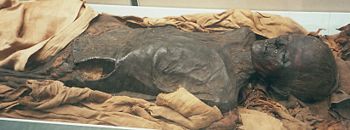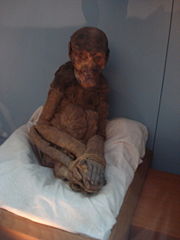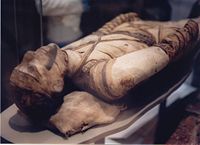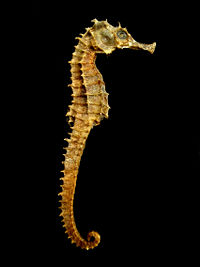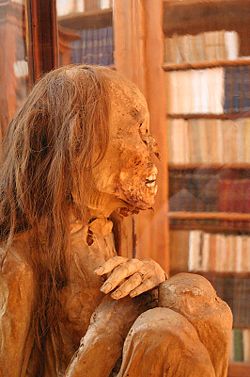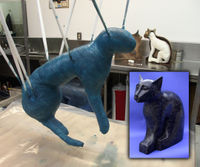Mummy
2008/9 Schools Wikipedia Selection. Related subjects: Archaeology
A mummy is a corpse whose skin and flesh have been preserved by either intentional or incidental exposure to chemicals, extreme cold, very low humidity, or lack of air when bodies are submerged in bogs. Mummies of humans and other animals have been found throughout the world, both as a result of natural preservation through unusual conditions, and as cultural artifacts to preserve the dead.
Etymology
| Mummy (sˁḥ) in hieroglyphs |
|||
|
The English word mummy is derived from medieval Latin mumia, a borrowing of the Persian or Arabic word mūmiyyah (مومية), which means " bitumen". Because of the blackened skin of mummies, bitumen was once thought to be used extensively in ancient Egyptian embalming procedures.
Deliberately embalmed mummies
The best known mummies are those that have been deliberately embalmed with the specific purpose of preservation, particularly those in ancient Egypt, where not only humans but also crocodiles and cats were mummified. Ancient Greek historians record that the Persians sometimes mummified their kings and nobility in wax, though this practice has never been documented in Egypt. The body of a Persian Princess which surfaced in 2004 in Pakistans mummy had a nature which turned out to have been forged. In China, preserved corpses have been recovered from submerged cypress coffins packed with medicinal herbs. Although Egyptian mummies are the most famous, the oldest mummies recorded are the Chinchorro mummies from northern Chile and southern Peru. Also among the oldest is Uan Muhuggiag which is a place in the central Sahara, and the name of the mummy of a small boy found there in 1958 by Professor Fabrizio Mori. The mummy displays a highly sophisticated mummification technique, and at around 5,500 years old is older than any comparable Ancient Egyptian mummy. The monks of Palermo in Sicily began mummifying their dead in 1599, and gradually other members of the community wished to have their bodies preserved as a status symbol. The last person to be mummified there died in the 1920s. The Capuchin catacombs of Palermo contain thousands of bodies, many which are clothed and standing, however in many cases the preservation was not successful with only the skeleton and clothing surviving.
Ancient Egypt
Although mummification existed in other cultures, eternal life was the main focus of all Ancient Egyptians, which meant preserving the body forever. Egyptian culture believed the body was home in the afterlife to a person's Ka and Ba, without which it would be condemned to eternal wandering.
The earliest known Egyptian "mummified" individual dates back to approximately 3300 BC. This individual, nicknamed ' Ginger' because of the colour of his hair, is not internationally renowned despite being older than other famous mummies, such as Rameses II or Seti I. Currently on display in the British Museum, Ginger was discovered buried in hot desert sand. Desert conditions can naturally preserve bodies so it is uncertain whether the mummification was intentional or not. However, since Ginger was buried with some pottery vessels it is likely that the mummification was a result of preservation techniques of those burying him. Stones might have been piled on top to prevent the corpse from being eaten by jackals and other scavengers and the pottery might have held food and drink which was later believed to sustain the deceased during the journey to the other world. While there are no written records of religion from that time, the beliefs of those who buried Ginger could have resembled the later religion to some extent.
The earliest technique of deliberate mummification, as used ca. 3000 BC, was minimal and not yet mastered. The organs were eventually removed (with the exception of the heart) and stored in canopic jars, allowing the body to be more well-preserved as it rested. Occasionally embalmers would break the bone behind the nose, and break the brain into small pieces in order that it could be pulled out through the nasal passage. The embalmers would then fill the skull with thick plant-based resin or plant resin sawdust.
It also wasn’t until the Middle Kingdom that embalmers used natural salts to remove moisture from the body. The salt-like substance natron dried out and preserved more flesh than bone. Once dried, mummies were ritualistically anointed with oils and perfumes. The 21st Dynasty brought forth its most advanced skills in embalming and the mummification process reached its peak. The bodies' abdomens were opened and all organs, except for the heart, were removed and preserved in Canopic jars. The brain, thought to be useless, was pulled out through the nose with hooks, then discarded. It was also drained through the nose after being liquefied with the same hooks.
The emptied body was then covered in natron, to speed up the process of dehydration and prevent decomposition. Natron dries the body up faster than desert sand, preserving the body better. Often finger and toe protectors were placed over the mummies fingers and toes to prevent breakage. They were wrapped with strips of white linen that protected the body from being damaged. After that, they were wrapped in a sheet of canvas to further protect them. Many sacred charms and amulets were placed in and around the mummy and the wrappings. This was meant to protect the mummy from harm and to give good luck to the Ka of the mummy. Once preserved, the mummies were laid to rest in a sarcophagus inside a tomb, where it was believed that the mummy would rest eternally. In some cases the mummy's mouth would later be opened in a ritual designed to symbolize breathing, giving rise to legends about revivified mummies.
Egyptian mummies as a commodity
- In the Middle Ages, based on a mis-translation from Arabic it became common practice to grind mummies preserved in bitumen into a powder to be sold and used as medicine. When actual mummies became unavailable, the sun-desiccated corpses of criminals, slaves and suicidal people were substituted by mendacious merchants. The practice developed into a wide-scale business which flourished until the late 16th century. Two centuries ago, mummies were still believed to have medicinal properties against bleeding, and were sold as pharmaceuticals in powdered form as in Mellified Man.
- Artists also made use of Egyptian mummies; the brownish paint known as Caput mortuum (Latin for death's head) was originally made from the wrappings of mummies. It was most popular in the 17th century but was discontinued in the early 19th century when its composition became generally known to artists.
- In the 19th century, European aristocrats would occasionally entertain themselves by purchasing mummies, having them unwrapped, and holding observation sessions. These sessions destroyed hundreds of mummies, because the exposure to the air caused them to disintegrate.
- An urban myth of mummies being used as fuel for locomotives was popularized by Mark Twain, but the truth of the story remains a debate.
- During the American Civil War, mummy-wrapping linens were said to have been used to manufacture paper. Evidence for the reality of these claims is still equivocal.
- Many thousands of mummified cats were sent from Egypt to England to be processed for use in fertilizer.
Scientific study of Egyptian mummies
Egyptian mummies became much sought-after by museums worldwide in the 19th and early 20th centuries and many exhibit mummies today. Notably fine examples are exhibited at the Egyptian Museum in Cairo, at the Ägyptisches Museum in Berlin, and at the British Museum in London. The Egyptian city of Luxor is also home to a specialized Mummification Museum. The mummified remains of what turned out to be Ramesses I ended up in a "Daredevil Museum" near Niagara Falls on the United States–Canada border; records indicate that it had been sold to a Canadian in 1860 and exhibited alongside displays such as a two-headed calf for nearly 140 years, until a museum in Atlanta, Georgia, which had acquired the mummy along with other artifacts, determined it to be royal and returned it to Egypt's Supreme Council of Antiquities. It is currently on display in the Luxor Museum.
More recently, science has also taken interest in mummies. Dr. Bob Brier, an Egyptologist, has been the first modern scientist attempted to recreate a mummy using the ancient Egyptian method. Mummies have been used in medicine to calibrate CAT scan machines at levels of radiation that would be too dangerous for use on living people. In fact, mummies can be studied without unwrapping them using CAT scan and X-ray machines to form a digital image of what's inside. They have been very useful to biologists and anthropologists, as they have provided a wealth of information about the health and life expectancy of ancient people.
Scientists interested in cloning the DNA of mummies have recently reported findings of clonable DNA in an Egyptian mummy dating to circa 400 BC. Although analysis of the hair of Ancient Egyptian mummies from the Late Middle Kingdom has revealed evidence of a stable diet, Ancient Egyptian mummies from circa 3200 BC show signs of severe anaemia and hemolytic disorders.
Natural mummies
Mummies that are formed as a result of naturally-occurring environmental conditions, such as extreme coldness ( Ötzi the Iceman, the Ice Maiden), acid ( Tollund Man), salinity ( Salt Man), or desiccating dryness ( Tarim mummies), have been found all over the world. More than a thousand Iron Age corpses, so called bog bodies, have been found in bogs in northern Europe, such as the Yde Girl and the Lindow Man. Natural mummification of other animal species also occurs; this is most common in species from shallow saline water environments, especially those with a body structure which is particularly favourable to this process, such as seahorses and starfish. Old mummies such as the dinosaurs Leonardo and Dakota in America were very valuable discoveries.
Europe
Italy
Natural mummification is fairly rare, requiring specific conditions to occur, but it has produced some of the oldest known mummies. The most famous ancient mummy is Ötzi the Iceman, frozen in a glacier in the Ötztal Alps around 3300 BC and found in 1991.
Bog bodies
The United Kingdom, the Republic of Ireland, Germany, the Netherlands, Sweden and Denmark have all produced a number of bog bodies, mummies of people deposited in sphagnum bogs, apparently as a result of murder or ritual sacrifices. In such cases, the acidity of the water, cold temperature and lack of oxygen combined to tan the body's skin and soft tissues. The skeleton typically disintegrates over time. Such mummies are remarkably well-preserved on emerging from the bog, with skin and internal organs intact; it is even possible to determine the contents of last meal was by examining the stomach. A famous case is that of the Haraldskær Woman, who was discovered by labourers in a bog in Jutland in 1835. She was erroneously identified as an early medieval Danish queen, and for that reason was placed in a royal sarcophagus at the Saint Nicolai Church, Vejle, where she currently remains.
In South America
Some of the best-preserved mummies date from the Inca period in Peru and Chile some 500 years ago, where children were ritually sacrificed and placed on the summits of mountains in the Andes. Also found in this area are the Chinchorro mummies, which are among the oldest mummified bodies ever found. The cold, dry climate had the effect of desiccating the corpses and preserving them intact. In 1995, the frozen body of a 12- to 14-year-old Inca girl who had died some time between 1440 and 1450 was discovered on Mount Ampato in southern Peru. Known as " Mummy Juanita" ("Momia Juanita" in Spanish) or "The Ice Maiden", some archaeologists believe that she was a human sacrifice to the Inca mountain god Apus.
In Russia
In the summer of 1993, a team of Russian archaeologists led by Dr. Natalia Polosmak discovered the Siberian Ice Maiden in a sacred area known as the Pastures of Heaven, on the Pontic-Caspian steppe in the Altay Mountains near the Mongolian border. Mummified, then frozen by unusual climatic conditions in the fifth century B.C. along with six decorated horses and a symbolic meal for her last journey, she is believed to have been a shaman of the lost Pazyryk culture. Her body was covered with vivid blue tattoos of mythical animal figures. The best preserved tattoos were images of a donkey, a mountain ram, two highly stylized deer with long antlers and an imaginary carnivore on the right arm. A man found with her (nicknamed "Conan") was also discovered, with tattoos of two monsters resembling griffins decorating his chest and three partially obliterated images which seem to represent two deer and a mountain goat on his left arm. The Ice Maiden has been a source of controversy, as alleged improper care after her removal from the ice resulted in rapid decay of the body; and since the breakup of the Soviet Union, the Altai Republic has demanded the return of various "stolen" artifacts, including the Ice Maiden, who is currently stored in Novosibirsk in Siberia.
In North America
In 1972, eight remarkably preserved mummies were discovered at an abandoned Inuit settlement called Qilakitsoq, in Greenland. The "Greenland Mummies" consisted of a six-month old baby, a four year old boy, and six women of various ages, who died around 500 years ago. Their bodies were naturally mummified by the sub-zero temperatures and dry winds in the cave in which they were found. The oldest preserved mummy in North America is Kwäday Dän Ts’ínchi ("Long ago person found" in the Southern Tutchone language of the Champagne and Aishihik First Nations), found in August 1999 by three First Nations hunters at the edge of a glacier in Tatshenshini-Alsek Park. It was determined that he had died about 550 years ago and that his preserved remains were the oldest ever discovered in North America.
Self-mummification
The Siberian Buryat lama Dashi-Dorzho Itigilov (1852–1927) aroused considerable interest in recent years, as his body was retrieved in a perfect state of mummification in 2002. Monks whose bodies remain incorrupt without any traces of deliberate mummification are venerated by some Buddhists who believe they successfully were able to mortify their flesh to death. "Buddhists say that only the most advanced masters can fall into some particular condition before death and purify themselves so that his dead body could not decay."
Many Mahayana Buddhist monks were reported to knew the time of death and left their last testaments and their students accordingly buried them sitting in lotus posture, put into a vessel with full of such as coal, wood, paper or lime and surrounded by bricks, and be exhumed after usually 3 years. The preserved bodies would be painted with paints and sticked with gold. Many were destroyed in China during the Cultural Revolution, some preserved, and some recent ones were reported.
Victor H. Mair claims that hundreds of mummified bodies of Tibetan monks were destroyed in China during the Cultural Revolution or were cremated by the Lamaists in order to prevent their desecration. Also according to Mair, the self-mummification of a Tibetan monk, who died ca. 1475 and whose body was retrieved relatively incorrupt in the 1990s, was achieved by the sophisticated practices of meditation, coupled with prolonged starvation and slow self-suffocation using a special belt that connected the neck with his knees in a lotus position.
Bodies purported to be those of self-mummified monks are exhibited in several Japanese shrines, and it has been claimed that the monks, prior to their death, stuck to a sparse diet made up of salt, nuts, seeds, roots, pine bark, and urushi tea. Some of them were buried alive in a pine-wood box full of salt.
Modern mummies
In the 1830s, Jeremy Bentham, the founder of utilitarianism, left instructions to be followed upon his death which led to the creation of a sort of modern-day mummy. He asked that his body be displayed to illustrate how the "horror at dissection originates in ignorance"; once so displayed and lectured about, he asked that his body parts be preserved, including his skeleton (minus his skull, for which he had other plans), which were to be dressed in the clothes he usually wore and "seated in a Chair usually occupied by me when living in the attitude in which I am sitting when engaged in thought." His body, outfitted with a wax head created because of problems preparing it as Bentham requested, is on open display in the University College London.
During the early 20th century the Russian movement of Cosmism, as represented by Nikolaj Fedorov, envisioned scientific resurrection of dead people. The idea was so popular that, after Lenin's death, Leonid Krasin and Alexander Bogdanov suggested to cryonically preserve his body and brain in order to revive him in the future. Necessary equipment was purchased abroad, but for a variety of reasons the plan was not realized. Instead his body was embalmed and placed on permanent exhibition in the Lenin Mausoleum in Moscow, where it is displayed to this day. The mausoleum itself was modeled by Aleksey Shchusev on the Pyramid of Djoser and the Tomb of Cyrus.
In the state of Guanajuato, Mexico, mummies were discovered in a cemetery of a city named Guanajuato northwest of Mexico City (near León). They are accidental modern mummies and were literally "dug up" between the years 1896 and 1958 when a local law required relatives of the deceased to pay a kind of grave tax. The Guanajuato mummies are on display in the Museo de las momias, high on a hill overlooking the city. Another notable example of natural mummification in modern times is Christian Friedrich von Kahlbutz (1651-1702), whose body is on exhibit in his native Kampehl.
In 1994 265 mummified bodies were found in the crypt of a Dominican church in Vác, Hungary from the 1729-1838 period. The discovery proved to be scientifically important, and by 2006 an exhibition was established in the Museum of Natural History in Budapest. In March 2006, the body of the Greek Orthodox Monk Vissarion Korkoliacos was found intact in his tomb, after fifteen years in grave. The event has led to a dispute between those who believe the preservation to be a miracle and those who claimed the possibility of natural mummification.
Summum
In 1975, an esoteric organization by the name of Summum introduced "Modern Mummification", a form of mummification that Summum claims uses modern techniques along with aspects of ancient methods. The service is available for spiritual reasons. Summum considers animals and people to have an essence that continues following the death of the body, and their mummification process is meant to preserve the body as a means to aid the essence as it transitions to a new destination. Summum calls this "transference," and the concept seems to correlate with ancient Egyptian reasons for mummification.
Rather than using a dehydration process that is typical of ancient mummies, Summum uses a chemical process that is supposed to maintain the body's natural look. The process includes leaving the body submerged in a tank of preservation fluid for several months. Summum claims its process preserves the body so well that the DNA will remain intact far into the future, leaving open the possibility for cloning should science perfect the technique on humans.
According to news stories, Summum has mummified numerous pets such as birds, cats, and dogs. People were mummified early on when Summum developed its process and many have made personal, "pre-need" arrangements. Summum has been included in television programs by National Geographic and the British Broadcasting Corporation, and is also discussed in the book The Scientific Study of Mummies by Arthur C. Aufderheide.
Plastination
Plastination is a technique used in anatomy to conserve bodies or body parts. The water and fat are replaced by certain plastics, yielding specimens that can be touched, do not smell or decay, and even retain most microscopic properties of the original sample.
The technique was invented by Gunther von Hagens when working at the anatomical institute of the University of Heidelberg in 1978. Von Hagens has patented the technique in several countries and is heavily involved in its promotion, especially with his travelling exhibition Body Worlds, exhibiting plastinated human bodies internationally. He also founded and directs the Institute for Plastination in Heidelberg.
Mummies in fiction
Mummies are commonly featured in romance genres as an undead creature. During the 20th century, horror films and other mass media popularized the notion of a curse associated with mummies. Films representing such a belief include the 1932 film The Mummy starring Boris Karloff as Imhotep; four subsequent 1940's Universal Studios mummy films which featured a mummy named Kharis, who also was the title mummy in a 1959 Hammer remake of The Mummy's Hand and The Mummy's Tomb; and a remake of the original film that was released in 1999. The belief in cursed mummies probably stems in part from the supposed curse on the tomb of Tutankhamun. ABC's 1979 TV holiday film aired The Halloween That Almost Wasn't where a mummy from Egypt (Robert Fitch) arrived into Count Dracula's castle without speaking.
The 1922 discovery of Tutankhamun's tomb by archaeologist Howard Carter brought mummies into the mainstream. Slapstick comedy trio the Three Stooges humoursly exploited the discovery in the short film We Want Our Mummy, in which they explored the tomb of the midget King Rutentuten (and his Queen, Hotsy Totsy). A decade later, they were crooked used chariot salesmen in Mummy's Dummies, in which they ultimately assist a different King Rootentootin ( Vernon Dent) with a toothache.
Fictional mummies have also been prominently featured in comics and animation, such as Hakushin in the anime series InuYasha, Anal Ho Tep from Eric Millikin's Fetus-X, N'Kantu, the Living Mummy from Marvel Comics, and Mumm-Ra from the animated TV series ThunderCats. A humorous cartoon mummy was also used as the mascot for General Mills' monster-themed breakfast cereal Yummy Mummy.
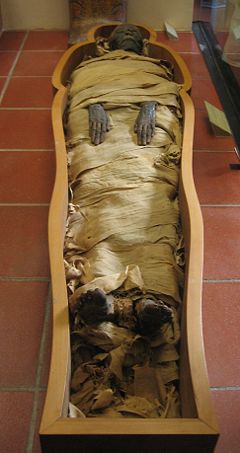
![O34 [z] z](../../images/733/73334.png)
![D36 [a] a](../../images/733/73335.png)
![V28 [H] H](../../images/733/73336.png)
